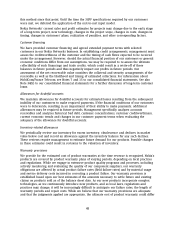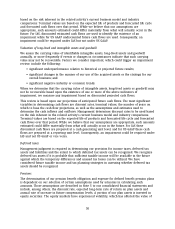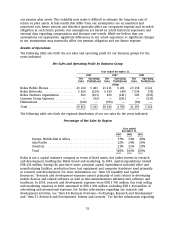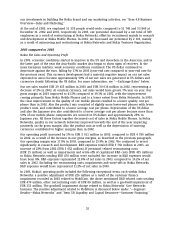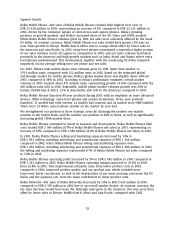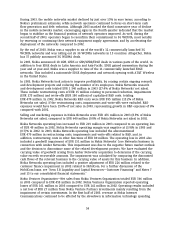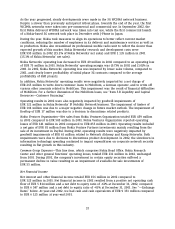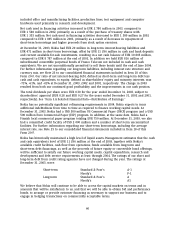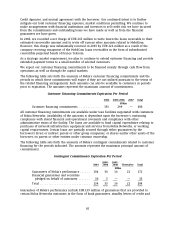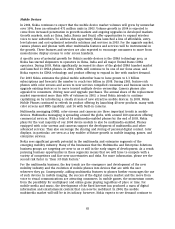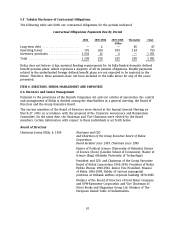Nokia 2003 Annual Report Download - page 58
Download and view the complete annual report
Please find page 58 of the 2003 Nokia annual report below. You can navigate through the pages in the report by either clicking on the pages listed below, or by using the keyword search tool below to find specific information within the annual report.As the year progressed, steady developments were made in the 3G WCDMA network business.
Despite a slower than previously anticipated rollout phase, towards the end of the year, the first
WCDMA networks were taken into pre-commercial and commercial use. In September 2002, the
first Nokia delivered WCDMA network was taken into test use, while the first commercial launch
of a Nokia-based 3G network took place in December with J-Phone in Japan.
During the year, Nokia took measures to align its operations to better reflect current market
conditions, reducing the number of employees in its delivery and maintenance services as well as
in production. Nokia also streamlined its professional mobile radio unit to reflect the slower than
expected growth of this market. Nokia Networks’ research and development costs were
EUR 995 million in 2002 (15.2% of Nokia Networks’ net sales) and EUR 1 135 million in 2001
(15.1% of Nokia Networks’ net sales).
Nokia Networks’ operating loss decreased to EUR 49 million in 2002 compared to an operating loss
of EUR 73 million in 2001. Nokia Networks’ operating margin was (0.7)% in 2002 and (1.0)% in
2001. In 2002, Nokia Networks’ operating loss was impacted by lower sales volume, compared to
2001, and clearly lower profitability of initial phase 3G contracts compared to the average
profitability of GSM projects.
In addition, Nokia Networks’ operating results were negatively impacted by a net charge of
EUR 265 million to write down customer loans to MobilCom, a German operator, and to write off
various other amounts related to MobilCom. This impairment was the result of financial difficulties
of MobilCom. For a further discussion of the MobilCom loans, see ‘‘Item 5.B Liquidity and Capital
Resources—Customer Financing.’’
Operating results in 2002 were also negatively impacted by goodwill impairments of
EUR 121 million in Nokia Networks’ IP Mobility Network business. The impairment of Amber of
EUR 104 million was due to a major negative change in future market outlook. The impairment of
Rooftop of EUR 17 million was due to a decision to discontinue related products.
Nokia Ventures Organization—Net sales from Nokia Ventures Organization totaled EUR 459 million
in 2002 compared to EUR 585 million in 2001. Nokia Ventures Organization reported operating
losses of EUR 141 million in 2002 compared to EUR 855 million in 2001. Operating results included
a net gain of EUR 81 million from Nokia Venture Partners investments mainly resulting from the
sale of its investment in PayPal. During 2002, operating results were negatively impacted by
goodwill impairments of EUR 61 million related to Network Alchemy and Ramp Networks. Both
impairments were due to decisions to discontinue product development. In 2002, the slowdown in
information technology spending continued to impact expenditures on corporate network security
resulting in flat growth in this industry.
Common Group Expenses—This line item, which comprises Nokia Head Office, Nokia Research
Center and other general functions’ operating losses, totaled EUR 231 million in 2002, unchanged
from 2001. During 2002, the company’s investment in certain equity securities suffered a
permanent decline in value resulting in an impairment of available-for-sale investments of
EUR 55 million.
Net Financial Income
Net interest and other financial income totaled EUR 156 million in 2002 compared to
EUR 125 million in 2001. Net financial income in 2002 resulted from a positive net operating cash
flow of EUR 5 814 million and a net debt to equity ratio of -61% at December 31, 2002, compared
to EUR 6 547 million and a net debt to equity ratio of -41% at December 31, 2001. See ‘‘—Exchange
Rates’’ below. At year-end 2002, we had cash and cash equivalents of EUR 9 351 million compared
to EUR 6 125 million at year-end 2001.
57



